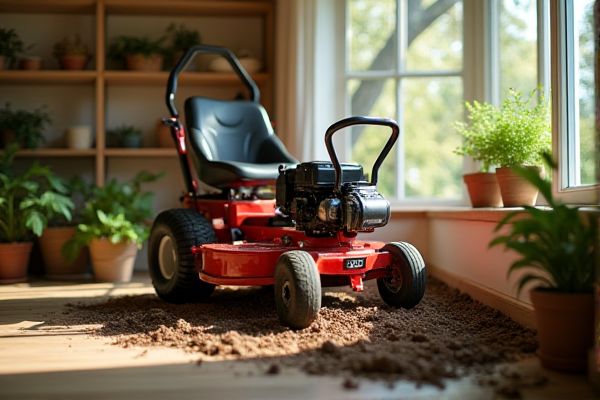
Choosing between a rototiller and a cultivator depends on your soil preparation needs, as rototillers are more powerful for breaking tough, compacted soil while cultivators are ideal for lighter, surface-level soil aeration and weed control. Explore the rest of the article to determine which tool best suits your gardening requirements and ensures the health of your soil.
Table of Comparison
| Feature | Rototiller | Cultivator |
|---|---|---|
| Purpose | Breaks hard soil, deep tilling | Loosens soil, weed control, shallow tilling |
| Engine Power | Higher power, gas or electric | Lower power, often electric or smaller gas engines |
| Tilling Depth | 6-12 inches (15-30 cm) | Up to 4 inches (10 cm) |
| Size & Weight | Larger, heavier (30-70 lbs / 14-32 kg) | Smaller, lighter (10-30 lbs / 4.5-14 kg) |
| Ideal For | New garden beds, breaking hard soil, large areas | Garden maintenance, weed control, cultivating between plants |
| Cost | Higher ($300-$1000+) | Lower ($100-$400) |
| Soil Preparation Speed | Faster for large or tough areas | Slower, suited for spot treatments |
Introduction to Rototillers and Cultivators
Rototillers and cultivators are essential garden tools designed for soil preparation and aeration. Rototillers feature rotating blades that dig deeply to break up compacted soil, making them ideal for new garden beds and large areas, while cultivators typically have smaller tines suited for loosening soil and mixing in fertilizers around established plants. Understanding the difference between these tools helps you choose the right equipment to improve soil health and optimize your gardening efforts.
Key Differences Between Rototillers and Cultivators
Rototillers feature larger, heavy-duty tines designed for deep soil penetration, making them ideal for breaking new ground and preparing large areas for planting. Cultivators have smaller, more precise tines better suited for weed control and soil aeration in established gardens or flower beds. The main distinction lies in their power and purpose: rototillers handle intense soil disruption, while cultivators focus on maintaining and refining already tilled soil.
How Rototillers Work
Rototillers use a powered engine to rotate sharp tines that dig deep into the soil, breaking up compacted ground and mixing organic material for improved aeration. These machines efficiently till large garden beds or fields by penetrating several inches into the soil, loosening it to prepare for planting. Their design allows for heavy-duty soil turning, making them ideal for initial soil preparation compared to cultivators that focus on surface-level weed control.
How Cultivators Work
Cultivators work by using rotating tines to break up and aerate the soil, making it easier to plant and allowing nutrients to penetrate more effectively. Unlike rototillers, which dig deeper and turn the soil thoroughly, cultivators target the upper soil layer to control weeds and prepare seedbeds. Your choice depends on the depth of soil preparation needed and the size of the area you plan to work on.
Soil Preparation: Which Tool is Best?
Rototillers excel in deep soil preparation and breaking up compacted ground, making them ideal for larger garden areas needing thorough tilling. Cultivators work best for lighter soil aeration and mixing in nutrients or compost in smaller or established garden beds. Your choice depends on the scale of your project and soil condition, with rototillers providing powerful soil turnover and cultivators offering precise, surface-level soil management.
Garden Size and Tool Selection
For small to medium garden sizes up to 1,000 square feet, cultivators offer precise soil aeration and weed control with lightweight, maneuverable designs ideal for tight spaces. Rototillers are better suited for larger gardens exceeding 1,000 square feet, providing powerful deep tilling to break up compacted soil and prepare extensive planting areas efficiently. Selecting between a rototiller and cultivator depends on garden size, soil condition, and desired depth of tillage, optimizing soil health and plant growth.
Power and Performance Comparison
Rototillers generally offer greater power and deeper soil penetration compared to cultivators, making them ideal for breaking new ground and handling tough, compacted soil. Cultivators are designed for lighter tasks like weeding and mixing amendments in already loosened soil, providing more maneuverability and precision in smaller garden spaces. Your choice depends on the scale and intensity of your gardening needs, with rototillers excelling in heavy-duty performance and cultivators suited for maintenance and fine soil preparation.
Ease of Use and Maneuverability
Rototillers generally require more physical effort due to their larger size and heavier weight, but they excel in breaking up compacted soil efficiently. Cultivators are lighter and more compact, making them easier to handle and maneuver in tight garden spaces, ideal for precision weeding and soil aeration. Both tools improve soil preparation, but cultivators offer better ease of use for small-scale gardening, while rototillers are suited for larger, tougher terrains.
Maintenance and Longevity
Rototillers generally require more frequent maintenance, including regular oil changes, spark plug replacements, and blade sharpening, to ensure optimal performance and longevity. Cultivators tend to have simpler mechanisms with fewer moving parts, resulting in lower maintenance needs and potentially longer operational life under light to moderate use. Proper storage, routine cleaning, and timely replacement of worn components are crucial for both tools to maximize durability.
Choosing the Right Tool for Your Gardening Needs
Selecting between a rototiller and a cultivator depends on the size and type of your gardening project; rototillers are ideal for breaking up large, compacted soil areas, while cultivators excel at aerating and mixing smaller garden beds. Your choice should consider soil depth requirements and the level of soil disturbance needed to prepare your garden effectively. Understanding these differences ensures you optimize soil health and plant growth with the right tool for your gardening needs.
 homyna.com
homyna.com